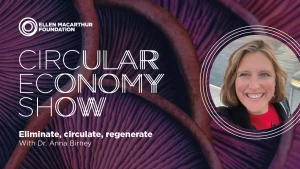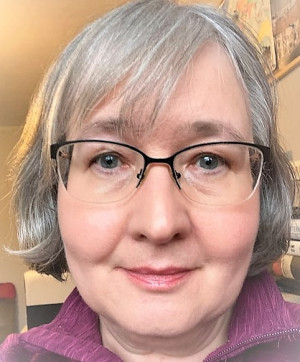
Systems change can help us understand and act for different challenges. Dr Anna Birney, CEO at the School of System Change, joined Lou on the Ellen MacArthur Foundation Circular Economy Show on 28th March 2023 to discuss how it applies to the Circular Economy. Watch the video or read the interview below to learn why the linear system is difficult to change and how systemic approaches can help us shift to circularity.
The Ellen MacArthur Foundation is a UK charity that develops and promotes the idea of a circular economy, which — driven by design, eliminates waste and pollution, circulates products and materials, and regenerates nature.
L — Lou
A — Anna
L: Anna, thanks so much for joining us today.
A: Pleasure.
L: Let’s cut straight to the chase. What is systems change and how can we apply it to the Circular Economy?
A: Systems change has been growing in its use over the last few years and we can understand it in two ways. One, we’re looking for systems change: we’re looking for the big changes in the system and we want to create the structural changes, we want to create the change in the way circularity happens. But we also can see it as a process: the way that we create change. So, how do we bring systems thinking and system practices to the work of circularity and how can we look at it from a different perspective.
L: Do you think that on the whole attitudes are changing?
A: I think if you take a systems view, attitudes are changing. But we might not be seeing it in the mainstream, we might not be seeing what’s happening in the big economy. But underneath the surface I think things are shifting. I think people are trying to adopt new practices, adopt new ways of doing things either on an individual level or at a business level. And so I think the attitude to the way we see our materials, the way we see the economy and the planet, are shifting but it doesn’t feel like it’s big enough or that the shift is momentum enough with what we’re looking for.
L: What do you think could speed things up? How do we create that urgency?
A: I’ve got a bit of a problem with the concept of urgency. We’re looking for speed and that’s part of the problem of our economy. That we’re consuming, we’re trying to get faster and get more. And I think we’re trying to apply that in the change making space as well. We’re trying to say ‘how do we get faster change,’ ‘do things more efficiently,’ ‘get things moving,’ and there’s almost something that we might need to stop and almost pause and slow down and not do very much. And that’s almost part of the challenge of it. So that doesn’t mean that change can’t happen at pace or significantly. But it’s almost like the idea of urgency is making people exhausted as well.
L: What do you think is possibly the biggest economic influence creating change at the moment? What could create change?
A: We have to change our relationship with the economy — how we see the economy. So we see the economy as constantly growing, we see the economy as something that’s almost bigger than our societal systems and definitely bigger than our environmental systems. But we need to flip that and we need to put it back in its place and say it’s here to serve people and planet — it’s not here to serve itself.
L: The system is so large and complex. Where can we begin to intervene?
A: A systems approach doesn’t ask us- there’s no one intervention point, it’s actually about how do we activate all the intervention points and coordinate them together. We ran a project with a coalition of people around single-use plastic water bottles and ‘how do we shift the system?’ The first thing we did was we tried to look at the narrative. It wasn’t actually about single-use plastic water bottles — that’s part of the problem. It was actually about how do we hydrate people, how do we give them water. So we need to reframe the purpose and how we understand what that means. Once we do that, we need to start understanding ‘what is the structure of the system,’ how might we restructure the system to deliver on a new model? And that was about finding fountains, about helping people change their individual behaviour, galvanising impacts around campaigns, getting people to use refillable water bottles. And then we also worked with government. We worked for the Greater London Authority, we worked with Parliament to bring it into policy.
So there’s no one intervention point [in a systems approach], it’s actually about how do we activate all the intervention points and coordinate them together from the structure side — the structure of how we get water. [Also] from the policy side and from the individual behaviour change. But the critical thing — and I think this is really important for circularity — is understanding the new models and actually trying to model new systems. We did some work on circular fashion and actually trying to find out ‘how do the different businesses work together?’ — and part of the problem and part of the challenge of circularity is not one business can usually find one model. You need a lot of the value chain to work together and to create a new network and a new business model. And one of the big challenges is businesses are not incentivised to innovate and to work together, in pre-competitive places.
L: And I guess this is where policy comes in doesn’t it?
A: When we think of policy we think of it as kind of telling people what to do and it’s kind of thing we do at the end. You know plastic bags — and it did a great job at the end. But actually what we need more of is creating the conditions for innovation. So it’s policy that supports the process of innovation, is actually what’s needed.
L: The system appears to be a bit stuck. So what would you say is the role of imagination and innovation?
A: We need imagination. We need to imagine what the new system can look like. We do a lot of Futures work as part of cultivating systems capacity, to getting people to imagine different scenarios, different pathways. But the key thing is not to just imagine a new future, but also to design it and to think about the structural design of what that looks like. And then when we can understand how — especially in an economy — the different parts might operate and work together and imagine that. Then we can start to find innovations and where people can intervene and connect.





